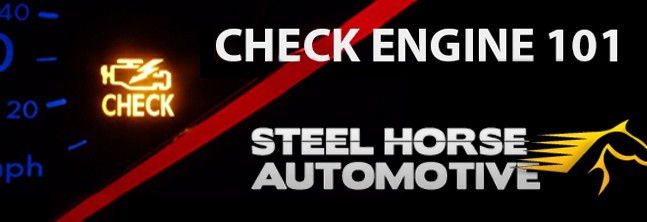Check Engine 101
The Check Engine Light on your vehicle has several different names and versions – it can also be called the Malfunction Indicator Light, or be referred to by its acronyms: CEL or MIL. Other versions of the light may be used for different vehicle systems – Anti-lock Brake System light, Traction Control System and so on. For simplicity, I’ll refer to any of these lights as a check engine lights for the rest of this article.
Whichever light we’re discussing, the purpose remains essentially the same: to alert the driver of an issue or problem with an on-board vehicle system.
When the check engine light is turned on by the computer, it means that there should be a trouble code stored in the computer that we at the shop can then scan with a scanner – the number of codes varies by vehicle manufacturer and vehicle configuration. In some vehicles, there are literally hundreds of different codes that could trigger the MIL!
Diagnosing the Issue
The first thing you should do when your check engine light comes on is to bring your vehicle to a trusted auto repair shop. To fix a check engine light issue, we first scan the code – a numerical code and description are usually retrieved from the vehicle which generally gives us an idea of what system has failed during vehicle operation. I say that it “…generally gives us an idea which system has failed…” for good reason; it gives us an idea of what system has failed – it does not tell us to “change this part…”
Repair
Since we believe that an educated customer will be a happier customer, here is the process we go through at Steel Horse Automotive to repair a check engine light issue.
- First we scan the code(s) from the computer in your vehicle.
- If we are to proceed with the repairs, we then run a diagnostic on the system that set the code(s).
- With the results of the diagnostic, we can determine if components need to be further tested, or if further diagnostics must be carried out.
- Once we have completed all diagnostics and testing, we can replace the required components or make the required repair, with customer approval of course.
- Codes can then be cleared and the vehicle road tested to verify the repair – in some cases a long period of time is required to verify the repair, so either the vehicle is left with us for some time, or the vehicle is returned to the customer and they are asked to return a few days later so a scan of the repaired system can be made to verify the repair.
After all is said and done, the problem is repaired and the customer is on their way.
Possible Issues
There are some other issues with check engine light repairs that usually aren’t explained to the customer which can lead to dissatisfaction:
- When the check engine light is on, the computer has detected a problem with an on-board system. When this happens, depending on the manufacturers programming of the vehicle, certain other on-board tests can no longer be performed, or certain systems can no longer work. Once the repairs are carried out and the codes cleared, these on-board tests can resume – if while the check engine light was on, other problems developed, the on-board systems might not have been able to detect the code, so the issue was not present when the original repair was carried out.
If this were to happen the check engine light might come back on a few days after the repair, once the computer found the other problem. When the check engine light is back on a customer might be under the impression that the shop didn’t properly repair their vehicle. In these cases, returning to the shop to have a second scan done will be required – if the code found is the same as the original code, there might have been an issue with the repair, if it’s a different code there might be other issues with the system. One example was a customer who had just had us repair a check engine light related fuel tank pressure sensor – the check engine light came back on so they returned to see us – once the same codes was retrieved they were a little agitated assuming we hadn’t properly repaired their car. The technician quickly checked the gas cap and found it loose, which was causing the code and check engine light to come back on. Tightening the cap and clearing the code got them happily back on their way with no further issues.
- If you are planning on having your vehicle emissions tested after having a repair made that involved a check engine light, please let us know. You have to drive the vehicle long enough after the repair to allow all on board systems to complete their self-checks, otherwise your vehicle will fail the test and you will need to retest the vehicle and pay again. We have the ability to test your vehicle for readiness before taking it for an E-test, just ask & we can scan it for you.
If your check engine light has come on or you have any questions about check engine repairs, contact us and we’ll be happy to help!

